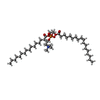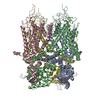[English] 日本語
 Yorodumi
Yorodumi- EMDB-30906: Structure of TRPC3 gain of function mutation R803C at 3.2 angstro... -
+ Open data
Open data
- Basic information
Basic information
| Entry | Database: EMDB / ID: EMD-30906 | |||||||||||||||
|---|---|---|---|---|---|---|---|---|---|---|---|---|---|---|---|---|
| Title | Structure of TRPC3 gain of function mutation R803C at 3.2 angstrom in 1340nM free calcium state | |||||||||||||||
 Map data Map data | SHARPENED MAP | |||||||||||||||
 Sample Sample |
| |||||||||||||||
 Keywords Keywords | TRPC3 / TRPC / calcium / gain of function / channel / MEMBRANE PROTEIN | |||||||||||||||
| Function / homology |  Function and homology information Function and homology informationpositive regulation of cardiac muscle hypertrophy in response to stress / Role of second messengers in netrin-1 signaling / store-operated calcium channel activity / Effects of PIP2 hydrolysis / Elevation of cytosolic Ca2+ levels / inositol 1,4,5 trisphosphate binding / calcium-activated cation channel activity / cation channel complex / TRP channels / response to ATP ...positive regulation of cardiac muscle hypertrophy in response to stress / Role of second messengers in netrin-1 signaling / store-operated calcium channel activity / Effects of PIP2 hydrolysis / Elevation of cytosolic Ca2+ levels / inositol 1,4,5 trisphosphate binding / calcium-activated cation channel activity / cation channel complex / TRP channels / response to ATP / positive regulation of calcium ion transport into cytosol / phototransduction / regulation of cytosolic calcium ion concentration / single fertilization / MECP2 regulates neuronal receptors and channels / response to calcium ion / calcium ion transmembrane transport / calcium channel activity / calcium ion transport / metal ion binding / plasma membrane Similarity search - Function | |||||||||||||||
| Biological species |  Homo sapiens (human) Homo sapiens (human) | |||||||||||||||
| Method | single particle reconstruction / cryo EM / Resolution: 3.2 Å | |||||||||||||||
 Authors Authors | Chen L / Guo W | |||||||||||||||
| Funding support |  China, 4 items China, 4 items
| |||||||||||||||
 Citation Citation |  Journal: Neuron / Year: 2022 Journal: Neuron / Year: 2022Title: Structural mechanism of human TRPC3 and TRPC6 channel regulation by their intracellular calcium-binding sites. Authors: Wenjun Guo / Qinglin Tang / Miao Wei / Yunlu Kang / Jing-Xiang Wu / Lei Chen /  Abstract: TRPC3 and TRPC6 channels are calcium-permeable non-selective cation channels that are involved in many physiological processes. The gain-of-function (GOF) mutations of TRPC6 lead to familial focal ...TRPC3 and TRPC6 channels are calcium-permeable non-selective cation channels that are involved in many physiological processes. The gain-of-function (GOF) mutations of TRPC6 lead to familial focal segmental glomerulosclerosis (FSGS) in humans, but their pathogenic mechanism remains elusive. Here, we report the cryo-EM structures of human TRPC3 in both high-calcium and low-calcium conditions. Based on these structures and accompanying electrophysiological studies, we identified both inhibitory and activating calcium-binding sites in TRPC3 that couple intracellular calcium concentrations to the basal channel activity. These calcium sensors are also structurally and functionally conserved in TRPC6. We uncovered that the GOF mutations of TRPC6 activate the channel by allosterically abolishing the inhibitory effects of intracellular calcium. Furthermore, structures of human TRPC6 in complex with two chemically distinct inhibitors bound at different ligand-binding pockets reveal different conformations of the transmembrane domain, providing templates for further structure-based drug design targeting TRPC6-related diseases such as FSGS. | |||||||||||||||
| History |
|
- Structure visualization
Structure visualization
| Movie |
 Movie viewer Movie viewer |
|---|---|
| Structure viewer | EM map:  SurfView SurfView Molmil Molmil Jmol/JSmol Jmol/JSmol |
| Supplemental images |
- Downloads & links
Downloads & links
-EMDB archive
| Map data |  emd_30906.map.gz emd_30906.map.gz | 79 MB |  EMDB map data format EMDB map data format | |
|---|---|---|---|---|
| Header (meta data) |  emd-30906-v30.xml emd-30906-v30.xml emd-30906.xml emd-30906.xml | 16.3 KB 16.3 KB | Display Display |  EMDB header EMDB header |
| Images |  emd_30906.png emd_30906.png | 52.4 KB | ||
| Filedesc metadata |  emd-30906.cif.gz emd-30906.cif.gz | 5.9 KB | ||
| Others |  emd_30906_half_map_1.map.gz emd_30906_half_map_1.map.gz emd_30906_half_map_2.map.gz emd_30906_half_map_2.map.gz | 77.1 MB 77.1 MB | ||
| Archive directory |  http://ftp.pdbj.org/pub/emdb/structures/EMD-30906 http://ftp.pdbj.org/pub/emdb/structures/EMD-30906 ftp://ftp.pdbj.org/pub/emdb/structures/EMD-30906 ftp://ftp.pdbj.org/pub/emdb/structures/EMD-30906 | HTTPS FTP |
-Related structure data
| Related structure data |  7dxeMC  7dxbC  7dxcC  7dxdC  7dxfC  7dxgC M: atomic model generated by this map C: citing same article ( |
|---|---|
| Similar structure data |
- Links
Links
| EMDB pages |  EMDB (EBI/PDBe) / EMDB (EBI/PDBe) /  EMDataResource EMDataResource |
|---|---|
| Related items in Molecule of the Month |
- Map
Map
| File |  Download / File: emd_30906.map.gz / Format: CCP4 / Size: 83.7 MB / Type: IMAGE STORED AS FLOATING POINT NUMBER (4 BYTES) Download / File: emd_30906.map.gz / Format: CCP4 / Size: 83.7 MB / Type: IMAGE STORED AS FLOATING POINT NUMBER (4 BYTES) | ||||||||||||||||||||||||||||||||||||||||||||||||||||||||||||||||||||
|---|---|---|---|---|---|---|---|---|---|---|---|---|---|---|---|---|---|---|---|---|---|---|---|---|---|---|---|---|---|---|---|---|---|---|---|---|---|---|---|---|---|---|---|---|---|---|---|---|---|---|---|---|---|---|---|---|---|---|---|---|---|---|---|---|---|---|---|---|---|
| Annotation | SHARPENED MAP | ||||||||||||||||||||||||||||||||||||||||||||||||||||||||||||||||||||
| Projections & slices | Image control
Images are generated by Spider. | ||||||||||||||||||||||||||||||||||||||||||||||||||||||||||||||||||||
| Voxel size | X=Y=Z: 1.045 Å | ||||||||||||||||||||||||||||||||||||||||||||||||||||||||||||||||||||
| Density |
| ||||||||||||||||||||||||||||||||||||||||||||||||||||||||||||||||||||
| Symmetry | Space group: 1 | ||||||||||||||||||||||||||||||||||||||||||||||||||||||||||||||||||||
| Details | EMDB XML:
CCP4 map header:
| ||||||||||||||||||||||||||||||||||||||||||||||||||||||||||||||||||||
-Supplemental data
-Half map: half map A
| File | emd_30906_half_map_1.map | ||||||||||||
|---|---|---|---|---|---|---|---|---|---|---|---|---|---|
| Annotation | half map A | ||||||||||||
| Projections & Slices |
| ||||||||||||
| Density Histograms |
-Half map: half map B
| File | emd_30906_half_map_2.map | ||||||||||||
|---|---|---|---|---|---|---|---|---|---|---|---|---|---|
| Annotation | half map B | ||||||||||||
| Projections & Slices |
| ||||||||||||
| Density Histograms |
- Sample components
Sample components
-Entire : human transient receptor potential channel 3 tetramer
| Entire | Name: human transient receptor potential channel 3 tetramer |
|---|---|
| Components |
|
-Supramolecule #1: human transient receptor potential channel 3 tetramer
| Supramolecule | Name: human transient receptor potential channel 3 tetramer / type: complex / ID: 1 / Parent: 0 / Macromolecule list: #1 |
|---|---|
| Source (natural) | Organism:  Homo sapiens (human) Homo sapiens (human) |
-Macromolecule #1: Short transient receptor potential channel 3
| Macromolecule | Name: Short transient receptor potential channel 3 / type: protein_or_peptide / ID: 1 / Number of copies: 4 / Enantiomer: LEVO |
|---|---|
| Source (natural) | Organism:  Homo sapiens (human) Homo sapiens (human) |
| Molecular weight | Theoretical: 96.118227 KDa |
| Recombinant expression | Organism:  Homo sapiens (human) Homo sapiens (human) |
| Sequence | String: MREKGRRQAV RGPAFMFNDR GTSLTAEEER FLDAAEYGNI PVVRKMLEES KTLNVNCVDY MGQNALQLAV GNEHLEVTEL LLKKENLAR IGDALLLAIS KGYVRIVEAI LNHPGFAASK RLTLSPCEQE LQDDDFYAYD EDGTRFSPDI TPIILAAHCQ K YEVVHMLL ...String: MREKGRRQAV RGPAFMFNDR GTSLTAEEER FLDAAEYGNI PVVRKMLEES KTLNVNCVDY MGQNALQLAV GNEHLEVTEL LLKKENLAR IGDALLLAIS KGYVRIVEAI LNHPGFAASK RLTLSPCEQE LQDDDFYAYD EDGTRFSPDI TPIILAAHCQ K YEVVHMLL MKGARIERPH DYFCKCGDCM EKQRHDSFSH SRSRINAYKG LASPAYLSLS SEDPVLTALE LSNELAKLAN IE KEFKNDY RKLSMQCKDF VVGVLDLCRD SEEVEAILNG DLESAEPLEV HRHKASLSRV KLAIKYEVKK FVAHPNCQQQ LLT IWYENL SGLREQTIAI KCLVVLVVAL GLPFLAIGYW IAPCSRLGKI LRSPFMKFVA HAASFIIFLG LLVFNASDRF EGIT TLPNI TVTDYPKQIF RVKTTQFTWT EMLIMVWVLG MMWSECKELW LEGPREYILQ LWNVLDFGML SIFIAAFTAR FLAFL QATK AQQYVDSYVQ ESDLSEVTLP PEIQYFTYAR DKWLPSDPQI ISEGLYAIAV VLSFSRIAYI LPANESFGPL QISLGR TVK DIFKFMVLFI MVFFAFMIGM FILYSYYLGA KVNAAFTTVE ESFKTLFWSI FGLSEVTSVV LKYDHKFIEN IGYVLYG IY NVTMVVVLLN MLIAMINSSY QEIEDDSDVE WKFARSKLWL SYFDDGKTLP PPFSLVPSPK SFVYFIMRIV NFPKCRRR R LQKDIEMGMG NSKSRLNLFT QSNSRVFESH SFNSILNQPT RYQQIMKRLI KRYVLKAQVD KENDEVNEGE LKEIKQDIS SLRYELLEDK SQATEELAIL IHKLSEKLNP SMLRCE UniProtKB: Short transient receptor potential channel 3 |
-Macromolecule #2: CHOLESTEROL HEMISUCCINATE
| Macromolecule | Name: CHOLESTEROL HEMISUCCINATE / type: ligand / ID: 2 / Number of copies: 8 / Formula: Y01 |
|---|---|
| Molecular weight | Theoretical: 486.726 Da |
| Chemical component information |  ChemComp-Y01: |
-Macromolecule #3: ZINC ION
| Macromolecule | Name: ZINC ION / type: ligand / ID: 3 / Number of copies: 4 / Formula: ZN |
|---|---|
| Molecular weight | Theoretical: 65.409 Da |
-Macromolecule #4: (2S)-3-(hexadecanoyloxy)-2-[(9Z)-octadec-9-enoyloxy]propyl 2-(tri...
| Macromolecule | Name: (2S)-3-(hexadecanoyloxy)-2-[(9Z)-octadec-9-enoyloxy]propyl 2-(trimethylammonio)ethyl phosphate type: ligand / ID: 4 / Number of copies: 4 / Formula: POV |
|---|---|
| Molecular weight | Theoretical: 760.076 Da |
| Chemical component information |  ChemComp-POV: |
-Macromolecule #5: [(2S)-2-[(E)-octadec-10-enoyl]oxy-3-oxidanyl-propyl] octadec-10-enoate
| Macromolecule | Name: [(2S)-2-[(E)-octadec-10-enoyl]oxy-3-oxidanyl-propyl] octadec-10-enoate type: ligand / ID: 5 / Number of copies: 4 / Formula: 98R |
|---|---|
| Molecular weight | Theoretical: 620.986 Da |
| Chemical component information |  ChemComp-98R: |
-Experimental details
-Structure determination
| Method | cryo EM |
|---|---|
 Processing Processing | single particle reconstruction |
| Aggregation state | particle |
- Sample preparation
Sample preparation
| Buffer | pH: 7.5 |
|---|---|
| Vitrification | Cryogen name: ETHANE |
- Electron microscopy
Electron microscopy
| Microscope | FEI TITAN KRIOS |
|---|---|
| Image recording | Film or detector model: GATAN K2 SUMMIT (4k x 4k) / Average electron dose: 50.0 e/Å2 |
| Electron beam | Acceleration voltage: 300 kV / Electron source:  FIELD EMISSION GUN FIELD EMISSION GUN |
| Electron optics | Illumination mode: FLOOD BEAM / Imaging mode: BRIGHT FIELD |
| Experimental equipment |  Model: Titan Krios / Image courtesy: FEI Company |
- Image processing
Image processing
| Startup model | Type of model: EMDB MAP EMDB ID: |
|---|---|
| Final reconstruction | Resolution.type: BY AUTHOR / Resolution: 3.2 Å / Resolution method: FSC 0.143 CUT-OFF / Number images used: 53304 |
| Initial angle assignment | Type: MAXIMUM LIKELIHOOD |
| Final angle assignment | Type: MAXIMUM LIKELIHOOD |
 Movie
Movie Controller
Controller


















 Z (Sec.)
Z (Sec.) Y (Row.)
Y (Row.) X (Col.)
X (Col.)





































